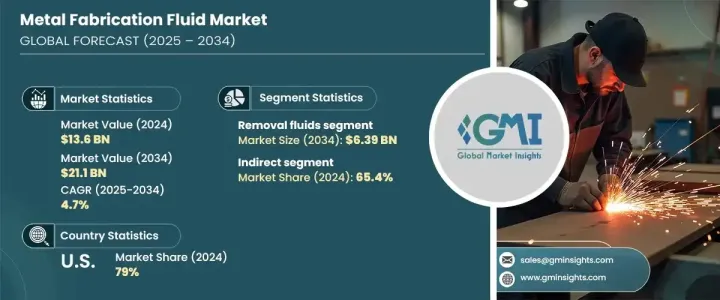
세계의 금속 가공유 시장은 2024년 136억 달러로 평가되었으며, 2025년부터 2034년까지 CAGR 4.7%로 예측되어 꾸준한 성장이 예상되고 있습니다.
이 성장은 특히 아시아태평양, 라틴아메리카, 아프리카의 일부 등 제조 활동이 급증하고 있는 지역에서의 급속한 산업 확대가 원동력이 되고 있습니다. 산업계가 생산성을 향상시키고 진화하는 품질 기준을 충족하기 위해 노력하고 있기 때문에 고성능 금속 가공유 수요가 높아지고 있습니다. 이러한 유체는 절단, 연삭, 용접, 성형 등의 금속 가공 공정에 필수적이며, 보다 부드러운 작업, 정밀도 향상, 기계 마모 및 손상 감소를 보장합니다. 기업이 생산 공정를 최적화하는 동안 작업 효율을 높이고 비용을 절감하기 위해 특수 유체에 대한 의존도가 계속 증가하고 있습니다. 자동화 및 정밀 머시닝을 포함한 고급 제조 방법으로의 전환은 혁신적이고 신뢰할 수 있는 금속 가공 오일의 필요성을 더욱 높여줍니다.

제조업체와 산업계는 세계 시장에서 경쟁력을 유지하기 위해 점점 업무 효율성을 우선시하고 있습니다. 금속 가공유는 기계의 유지보수 빈도를 최소화하면서 다운타임 감소, 가공 정밀도 향상, 재료 제거율 개선에 필수적입니다. 이러한 장점으로 인해 금속가공유는 자동차, 항공우주, 전자기기, 중장비 등의 분야에서 필수적입니다. 지속가능성과 환경 컴플라이언스에 대한 관심이 높아짐에 따라 제조업체는 친환경적이고 생분해성이 있는 액체의 개발을 촉구하고 있습니다. 이러한 추세는 환경 규제의 강화와 보다 친환경적인 제조 방법에 대한 세계의 뒷받침과 일치하며, 기술 혁신을 촉진하고 시장 성장을 가속하고 있습니다.
| 시장 범위 | |
|---|---|
| 시작 연도 | 2024년 |
| 예측 연도 | 2025-2034년 |
| 시작 금액 | 136억 달러 |
| 예측 금액 | 211억 달러 |
| CAGR | 4.7% |
제품 유형 중에서 제거액이 지배적인 부문으로 부상하여 2024년에는 39억 7,000만 달러에 달했고, 2034년에는 63억 9,000만 달러에 이를 것으로 예측되고 있습니다. 냉각수와 윤활제를 포함한 이러한 유체는 금속 칩, 칩 및 기타 가공 칩을 제거하고 원활한 생산 공정을 보장하는 데 매우 중요합니다. 금속 절단, 연삭 및 성형에 의존하는 산업은 우수한 제품 품질과 기계 수명 연장을 달성하기 위해 제거액에 크게 의존합니다.
금속가공유의 유통상황은 시장 확대의 또 다른 중요한 촉진요인입니다. 유통업체, 도매업체 및 리셀러를 포함한 간접 유통 경로는 2024년 시장 점유율의 65.4%를 차지했고, 2034년까지 137억 달러를 창출할 것으로 예측됩니다. 이러한 판매 채널은 특히 원격지나 서비스가 닿지 않는 지역에서 제조업체가 판매 경로를 확대하고 미개척 시장에 진입하여 제품 공급력을 높일 수 있습니다.
미국의 금속 가공유 시장은 2024년에는 79%의 압도적 점유율을 차지했고, 2034년까지의 CAGR은 4.8%로 예측됩니다. 이 나라의 견고한 산업 기반은 정밀 기계 가공과 자동화의 진보와 함께 특수 금속 가공 유제 수요를 강화하고 있습니다. 산업계가 최첨단 재료와 기술을 채택함에 따라 효율성과 제품 품질을 향상시키는 고성능 유체에 대한 요구는 계속 가속화되고 있으며, 미국은 세계 시장의 주요 기업로서 확고한 지위를 구축하고 있습니다.
The Global Metal Fabrication Fluid Market, valued at USD 13.6 billion in 2024, is poised for steady growth with a projected CAGR of 4.7% from 2025 to 2034. This growth is fueled by rapid industrial expansion, particularly across regions like Asia Pacific, Latin America, and parts of Africa, where manufacturing activities are surging. The demand for high-performance metalworking fluids is rising as industries strive to enhance productivity and meet evolving quality standards. These fluids are integral to metalworking processes such as cutting, grinding, welding, and forming, ensuring smoother operations, improved precision, and reduced wear and tear on machinery. As companies aim to optimize their production processes, the reliance on specialized fluids to boost operational efficiency and lower costs continues to grow. The shift toward advanced manufacturing practices, including automation and precision machining, has further amplified the need for innovative and reliable metal fabrication fluids.

Manufacturers and industries are increasingly prioritizing operational efficiency to stay competitive in the global marketplace. Metalworking fluids are essential in reducing downtime, enhancing machining precision, and improving material removal rates, all while minimizing the frequency of machinery maintenance. These benefits have made metal fabrication fluids indispensable in sectors such as automotive, aerospace, electronics, and heavy machinery. The growing focus on sustainability and environmental compliance has also encouraged manufacturers to develop eco-friendly and biodegradable fluid formulations. This trend aligns with stricter environmental regulations and the global push toward greener manufacturing practices, driving innovation and fostering market growth.
| Market Scope | |
|---|---|
| Start Year | 2024 |
| Forecast Year | 2025-2034 |
| Start Value | $13.6 Billion |
| Forecast Value | $21.1 Billion |
| CAGR | 4.7% |
Among product types, removal fluids emerged as a dominant segment, generating USD 3.97 billion in 2024 and anticipated to reach USD 6.39 billion by 2034. These fluids, which include coolants and lubricants, are critical in eliminating metal chips, swarf, and other machining debris, ensuring seamless production processes. Industries reliant on cutting, grinding, and shaping metals heavily depend on removal fluids to achieve superior product quality and extended machinery life.
The distribution landscape of metal fabrication fluids is another key driver of market expansion. Indirect distribution channels, including distributors, wholesalers, and resellers, accounted for 65.4% of the market share in 2024 and are projected to generate USD 13.7 billion by 2034. These channels enable manufacturers to broaden their reach, penetrate untapped markets, and enhance product availability, particularly in remote or underserved regions.
The United States metal fabrication fluid market held a commanding 79% share in 2024, with a projected CAGR of 4.8% through 2034. The country's robust industrial base, coupled with advancements in precision machining and automation, has intensified the demand for specialized metalworking fluids. As industries increasingly adopt cutting-edge materials and technologies, the need for high-performance fluids that enhance efficiency and product quality continues to accelerate, solidifying the US as a key player in the global market.